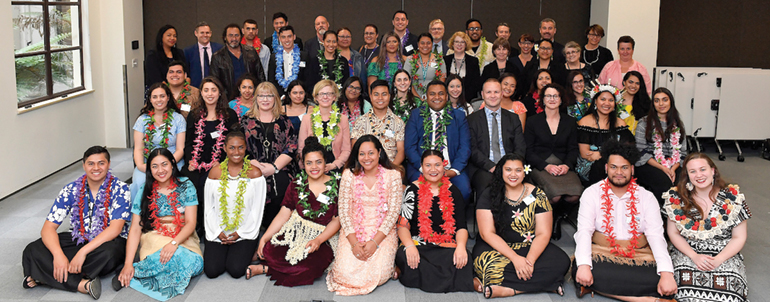Outcome Two: People are skilled and engaged in safe and fulfilling work
People need work that provides fair pay. But work is more than simply income; it can also give people a sense of purpose and allow them to develop skills, experience and social connections.
On this page

Text version of outcome two – progress
Skilled people do better socially and economically and are more resilient to change. They will also help businesses to drive innovation, productivity, growth and global competitiveness.
MBIE is responsible for ensuring that the labour market is functioning well to provide people with a safe and fair working environment. Accidents at work and poor employment relations damage workers, businesses and society.
We also influence the market to make sure people and businesses have access to the skills they need. Initiatives to boost skills are directed at specific groups, such as youth not in employment, education or training (NEET). Immigration is part of this picture, and we provide advice on overseas skills that Aotearoa-New Zealand may need.
Pasifika interns bring ‘diversity of thinking’ to policymaking
Pasifika tertiary students are making a unique and valuable contribution to public policy while they learn what it’s like to work for government.
The Tupu Tai Pasifika Public Sector Internship Programme provides an opportunity for top Pasifika students to explore public sector policy careers. As a result of the internship experience, 23 Tupu Tai graduates are now employed in permanent and fixed-term roles throughout the public service, while 32 students joined the 2018/2019 cohort as interns.
Agencies value the experiences and insights that interns bring to public policy work. By 2026 Pacific peoples are expected to make up 10 per cent of New Zealand’s population, yet only 1.2 per cent of all policy analysts in New Zealand are of Pacific descent.
Tupu Tai was a finalist in the Institute of Public Administration New Zealand Awards 2018.

Skilled drivers will help deliver big projects
A $2.8 million investment from the Provincial Growth Fund is helping unlock the economic potential of the Manawatū-Whanganui regions by training skilled drivers and machinery operators. Big projects, including the Manawatū Gorge Road Project and a new KiwiRail hub, will maximise Palmerston North’s potential to act as a major distribution centre for the lower North Island.
The funding will expand a national driver programme near Palmerston North to meet local and national labour shortages. The National Driver Training Centre (NDTC) at Manfeild Park in Feilding will train up to 700 drivers and machine operators a year. The NDTC ran more than 400 car and motorbike licences and more than 200 defensive driver training courses for the year ended June 2019. By the end of 2019 this will be expanded to deliver truck, digger, 4WD, forklift and roller training.

MBIE acts to protect migrant workers
Temporary migrant workers may be particularly vulnerable as they are less likely to be aware of their rights and entitlements than their New Zealand colleagues.
MBIE is investigating how they are being exploited in New Zealand, and what we can do to protect them.
Workers in the sex industry are particularly at risk, and this has been an area of focus for Immigration New Zealand over the last year. Only New Zealand citizens and permanent residents can legally work in the sex industry, so temporary migrants working unlawfully can be exposed to unscrupulous employers and clients.
This programme of work has included commissioning independent research, gathering information to better understand the particular challenges within this industry, and educating the industry itself to ensure employers, facilitators of service, and workers all understand their rights and legal obligations.
MBIE is leading a review into temporary migrant worker exploitation, which will result in draft recommendations to the Minister of Immigration on ways to better address temporary migrant worker exploitation.

Prosecutions for slavery, trafficking and exploitation
Arrests and prosecutions for slavery and human trafficking after joint action by Immigration New Zealand and New Zealand Police send a strong message to traffickers.
A New Zealand citizen was convicted for exploiting Indian workers he employed. The man was sentenced to nine months’ home detention, 200 hours of community service and ordered to pay $150,000 in victim reparation.
A Bangladeshi couple running a sweet-making business in Auckland were found not guilty in March of two human-trafficking charges but found guilty of exploiting migrants and jailed for four years and five months and two years and six months respectively.
A Samoan man was arrested in December 2018 and charged with human trafficking and slavery of Samoan nationals in the horticulture industry. The victims allege they were not paid, had passports taken, and were assaulted and threatened. The trial is pending.
In August 2018, as part of a broader joint investigation into this case, Fiji Police working with Immigration New Zealand investigations arrested a Fijian national in Fiji and charged her with a number of crimes, including human trafficking. In addition, in September 2018, a 10-month home detention sentence was handed down on five charges of providing false or misleading information to Immigration New Zealand.
New Zealand is committed to eliminating people trafficking and has a comprehensive all-of-government approach to combatting all forms of trafficking in persons.
Employment law under scrutiny
MBIE is leading the Government’s changes to employment law to deliver fair pay and conditions, working with the New Zealand Council of Trade Unions and BusinessNZ.
We have supported working groups on sector-level collective bargaining, improvements to the Holidays Act 2003, and bargaining rights for film production workers. We have helped develop legislation on employment relations, pay equity and pay for Members of Parliament.
The Film Industry Working Group has now agreed on a model that allows screen sector workers to continue as contractors with the right to bargain collectively and use a dispute-resolution scheme.
The Fair Pay Agreement Working Group, which was established to recommend a system of bargaining that sets minimum terms and conditions across industries or occupations, reported back in December 2018. The Holidays Act Taskforce is carrying out a review of the law and will report back in mid-2019.
MBIE has also provided support on the Equal Pay Amendment Bill. The Bill would allow workers to make a pay equity claim within New Zealand’s existing framework.

Strategy launched to reduce workplace accidents
The Government’s Health and Safety at Work Strategy 2018–2028 aims to reduce the number of injuries and deaths at work, and improve the wellbeing of all New Zealanders. MBIE developed the strategy with WorkSafe New Zealand and other stakeholders. It was launched in December 2018.

Case study – Operation targets broadband sub-contractors
Our aim
To make sure sub-contractors working for Chorus on the Government’s fibre broadband network rollout are employing staff according to minimum employment standards.
Our role
Following advice from E tū Union that sub-contractors were breaching employment standards, MBIE’s Intelligence and Risk Unit led an operation in June 2018 with labour inspectors, immigration officers, the Companies Office and Inland Revenue investigators. Seventy-two employers were identified as likely to be in breach. Since then a further 14 referrals have been received. Eleven cases remain under investigation.
The outcome
As at 30 June 2019 there were:
- 13 infringement notices issued, with total penalties of $22,000
- 47 improvement notices issued
- 3 enforceable undertakings issued
- 6 cases lodged with the Employment Relations Authority (ERA)
- 70 cases closed, 11 cases open
Chorus has since tabled an independent review into the employment practices of its sub-contractors in the fibre broadband network rollout. The review has promised a range of systems and process improvements for its subcontracting operations.
What this means for New Zealanders
The Labour Inspectorate is using the Chorus report as a case study to help other employers avoid the pitfalls of the sub-contracting model and show what they need to do to comply with employment standards.
What we're working towards
| Performance measure | Indicator | Current trend | Desired trend | Commentary |
|---|---|---|---|---|
| Increase skilled workforce (part one) | Qualification attainment rate: Percentage of 25–34-year-olds with New Zealand Qualifications Framework (NZQF) level 4 qualifications or above | Increase |
Increase |
The qualification attainment rate for young adults (measured by the percentage of 25–34-year-olds with NZQF level 4 qualifications or above) was 59.3% in the quarter to June 2019, 0.4 percentage points higher than in the quarter to June 2018. This is the highest recorded figure for a June quarter since 2004, continuing the consistent upward trend since 2015. |
| Increase skilled workforce (part two) | Skilled occupation rate | Increase |
Increase |
The skilled occupation rate is the proportion of people employed in an occupation assessed as ‘skilled or higher’ by the Australian and New Zealand Standard Classification of Occupations (ANZSCO). In the quarter to June 2019 it was 63.1%, 0.2 percentage points higher than in the quarter to June 2018. This rate has been increasing steadily since 2004. |
| Increase skill matching of migrants | Proportion of employed principal migrants whose occupations in New Zealand match their skills and NZ-ready qualifications | Increase |
Increase |
The proportion of employed principal migrants whose occupations in New Zealand match their skills and New Zealand-ready qualifications continued to increase. The proportion in 2018 was 88%, an increase from 85% in 2017. |
| Increase employment (split by ethnicity, region) | Total employment rate | Decrease |
Increase |
The seasonally adjusted employment rate in the quarter to June 2019 was 67.7%, compared to 67.8% in the quarter to June 2018. Despite this slight decrease, the employment rate is still near its highest level in over 20 years. |
| Reduce underutilisation (split by ethnicity, region) | Total underutilisation rate | Decrease |
Decrease |
The seasonally adjusted underutilisation rate in the quarter to June 2019 was 11.0%, the lowest June quarter rate since 2009. The underutilisation rate has been improving since 2012. |
| Reduce unemployment (split by ethnicity, region) | Total unemployment rate | Decrease |
Decrease |
The unemployment rate continued to improve by showing a further decline. The seasonally adjusted unemployment rate was 3.9% in the quarter to June 2019, falling from 4.4% in the quarter to June 2018. This is the lowest June quarter unemployment rate since 2009, close to the level it was prior to the global financial crisis in 2008. |
| Reduce proportion of people not in employment, education or training (NEET) (split by ethnicity, region) | NEET rate (15–24 years) | Decrease |
Decrease |
The proportion of youth (aged 15 to 24 years old) not in employment, education or training (NEET rate) continues to improve by showing a further decline. The seasonally adjusted NEET rate was 10.3% in the quarter to June 2019, the lowest June quarter rate in this decade. |
| Increase pay equity (split by ethnicity, region) | Difference in median hourly earnings for men and women | Increase |
Decrease |
The gender pay gap (measured by the percentage difference between men’s and women’s median hourly earnings) was 9.3% in the year to June 2019. This is slightly higher than in 2018 when it was 9.2%, but is still close to the lowest level seen in the last decade (which was 9.1% in 2012). |
| Reduce fatal and serious work-related injury (part one) | Fatal injury rate (age standardised rate per 100,000 FTE workers) | Steady |
Decrease |
The three-year average fatal injury rate (age standardised rate per 100,000 full-time equivalent (FTE) workers) remained at 2.1 for the period 2015–2017 (provisional figures), the same as it was in the 2014–2016 period, and the lowest it has been since 2002–2004 period. |
| Reduce fatal and serious work-related injury (part two) | Serious non-fatal injury rate (age standardised rate per 100,000 FTE workers) | Increase |
Decrease |
In 2017, the serious non-fatal injury rate (age standardised rate per 100,000 FTE workers) increased to 16.9, from the decade low rate of 14.3 in 2016. |
Performance of our services and functions

Text version of outcome two – output
How much we spent
| Actual 2017/18 $000 |
Our expenditure summary | Actual 2018/19 $000 |
Supplementary Estimates 2018/19 $000 |
Main Estimates 2018/19 $000 |
|---|---|---|---|---|
| 406,758 | Departmental expenses | 423,295 | 439,603 | 426,303 |
| 1,454,485 | Non-departmental expenses | 1,567,090 | 1,567,629 | 1,565,855 |
| – | Departmental capital | – | – | – |
| 9,552 | Non-departmental capital | – | – | – |
| 1,870,795 | Total expenditure for outcome | 1,990,385 | 2,007,232 | 1,992,158 |

